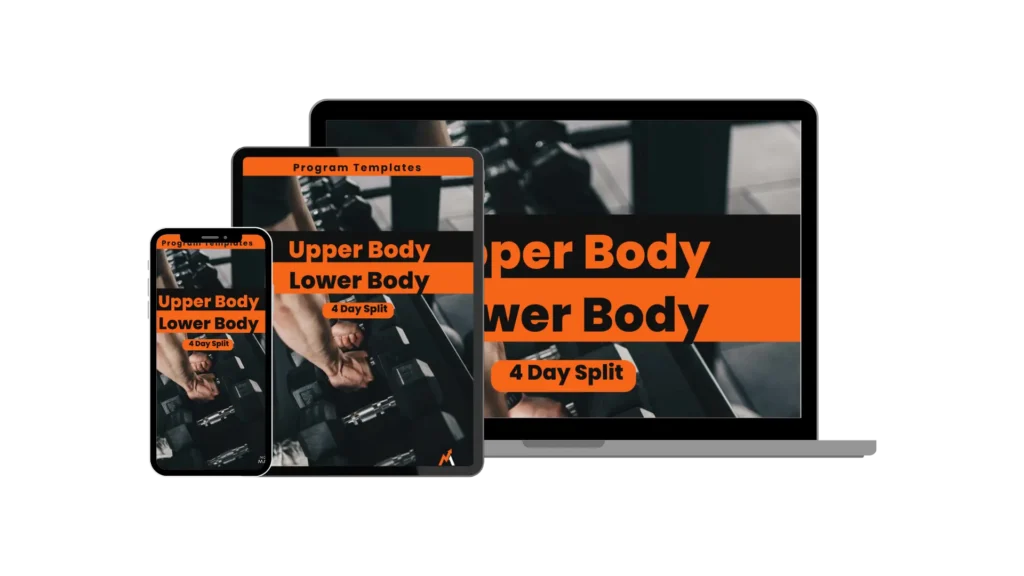The modified upper lower body split
what is the modified upper body lower body split?
The upper body lower body split is a great training split, however, one potential drawback is that the upper body days can become a little long. This will likely not be a problem for beginners and early intermediate lifters as they can progress on a fairly low amount of weekly volume. More advanced lifters who may need to perform more volume or those who simply prefer a higher volume approach may benefit from using a modified upper lower body split.

With a modified upper body lower body split, we move some of our upper body work to one or more of our lower body days, which will usually have fewer exercises. This distributes the work a little more evenly throughout our weekly training sessions. The general structure of the training split remains the same, with dedicated days to train the upper and lower body, however, some upper body work is performed on lower body days.
How To Set Up A Modified Upper Lower Body Split
There is no right or wrong way to set up a modified upper lower body split, and the setup you choose can be dictated by your goals and personal preferences. Some good options for upper body work to be performed on lower body days include:
Here are two common approaches to setting up a modified upper lower body split:
move biceps to lower body days
One of the simplest modified upper lower split setups involves moving your biceps training to your lower body days. This works quite well as they can be trained in a less fatigued state, rather than at the end of an upper body session, after you have trained pull movements which do involve some bicep work. (depending on how well you perform your pulling movements).
The nice thing about this setup is that your biceps will get some indirect work on your upper body days and direct work on your lower body days. The biceps are one of those muscle groups that will recover quickly so training back the day before biceps should not impact your biceps training, especially if you are performing back exercises correctly.
Other smaller muscle groups could also be trained on lower body days such as side delts. These often need more volume and also recover quickly, meaning you could perform them on back-to-back days. You could also train biceps and side delts together on lower body days. Supersetting these two movements is a good option to save time at the end of a lower body session.
| Monday | Upper Body |
| Tuesday | Lower Body + Biceps |
| Wednesday | Rest |
| Thursday | Upper Body |
| Friday | Lower Body + Biceps |
| Saturday | Rest |
| Sunday | Rest |
If you wanted to include more biceps and side delt work you could also work these muscle groups on upper and lower body days. Performing a few sets on upper body days and 3-4 sets on lower body days would still reduce the length of your upper body days while increasing the weekly volume of these muscle groups significantly.
If you did train biceps or side delts on upper and lower body days and you wanted a little more recovery you could train Monday, Tuesday, Thursday, And Saturday. This allows an extra day between upper body work on Thursday and Saturday.
Perform some back work on lower body days
Another modified upper lower body setup involves performing some back work on your lower body days. The back has many different muscle groups and performing a variety of movements emphasizing different angles is often required to see the best results. The back can also handle a lot of volume.
Some good options include extra work for the upper back and traps. Another option is to perform more lat focused work on your upper body days and more upper back, and trap work on lower body days. This can work well as one of your lower body days will likely involve trap work when performing deadlift variations for example.
If you have a specific goal such as increasing the amount of pull-ups you can perform, placing these on lower body days can also be a good option. You can train your back closer to muscular failure on your upper body days and get some extra volume in working further away from muscular failure on lower body days.
This ‘greasing the groove’ approach works well for bodyweight training, as we are practicing the skill and improving our strength without building up excessive fatigue throughout the week. A good option here is to have a rep target for each session, and slowly increase over time. Simply perform the desired amount of reps no matter how many sets it takes, without getting close to muscular failure. A RIR (reps in reserve) of 2-4 is a good target to aim for, staying further away from failure and focusing on quality reps.
| Monday | Upper Body |
| Tuesday | Lower Body+Back |
| Wednesday | Rest |
| Thursday | Upper Body |
| Friday | Rest |
| Saturday | Lower Body+Back |
| Sunday | Rest |
| Monday | Upper Body |
| Tuesday | Lower Body+Pull Ups |
| Wednesday | Rest |
| Thursday | Upper Body |
| Friday | Rest |
| Saturday | Lower Body+Pull Ups |
| Sunday | Rest |
Neglected Muscle Groups
Neglected muscle groups that often get left out can also be trained on lower body days, such as the lower traps, forearms, and neck muscles.
Who Can Benefit From A Modified Upper Lower Body Split?
A modified upper lower body split can be used by anyone, however, it is most useful for individuals who need to perform more volume and feel their upper body days are becoming a little drawn out. The modified upper lower body split will be of most use when an individual is running a 4-day upper lower body split. The same principles can be applied when running a 5-day setup, although with this setup, we will likely be training the upper body three times per week, therefore longer upper body days may not be so much of a concern.



